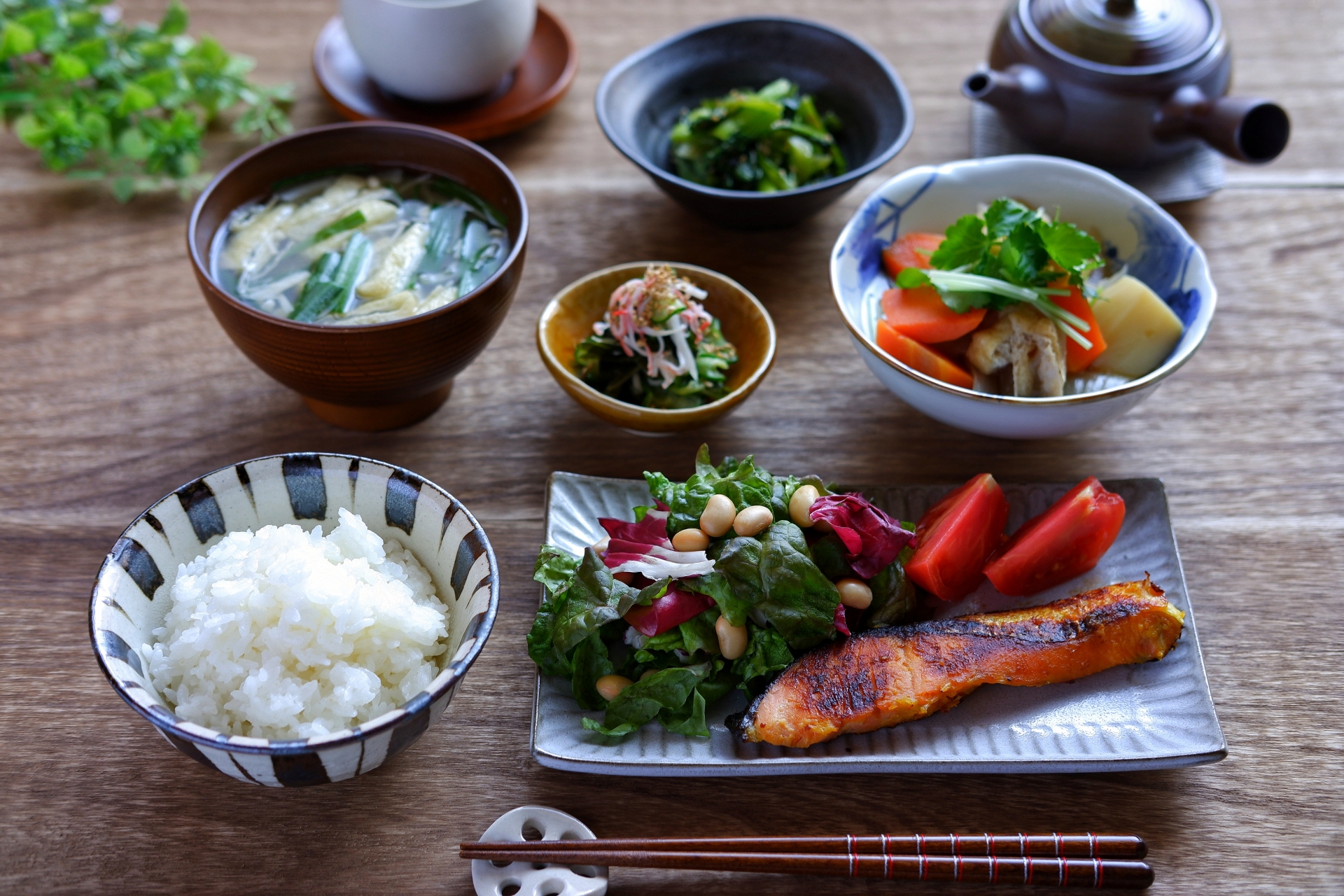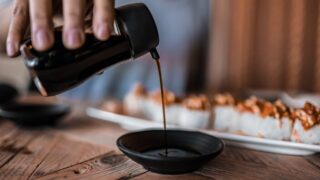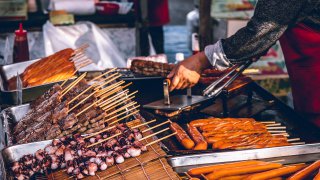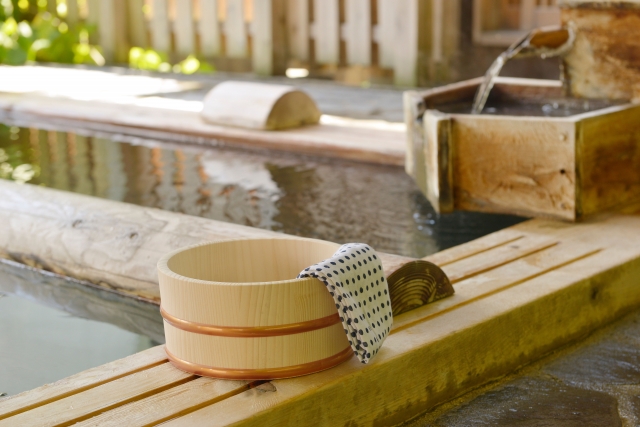
Miho Shimizu is a Japanese freelance writer settled in Shizuoka with her husband and two rabbits. Fascinated with travelling at the age of 18, she has spent most of her long holidays exploring incredible spots around Japan. Also love to listen to music, draw, and read novels over a cup of green tea.
This post may contain some affiliate links. When you click through and make a purchase we may receive some commission, at no extra costs to you.
Japan boasts a seemingly inexhaustible variety of qualities that make people want to visit- but what is almost always in the top three? Exactly- food! Japan has a few dishes, like sushi and ramen, that are world-famous- but there is much more to discover than just these two! Just think of all the different types of noodles, vegetables, and other ingredients that Japan specializes in, or that can only be found in Japan. Because Japan is an island country, it has developed a unique food culture with a range of ingredients produced within the country.
Japanese food has gained much popularity in the recent years as a healthy cuisine and the number of Japanese restaurants around the world is expanding rapidly. While there are traditional Japanese dishes that have been loved for over centuries, some modern recipes were created with influence of western countries, especially after Japan opened its borders after two centuries of isolation due to the Sakoku policy (1633 -1853). The best way to discover all the yummy Japanese food is of course trying it in Japan at all the different restaurants, or you can try them and buy ingredients at the same time at markets like Nishiki Market in Kyoto or Tsukiji Market in Tokyo. But, of course it is also possible to prepare some of the Japanese dishes yourself at home! Read along to learn all about the best Japanese dishes you can make at home- complete with ingredients and a brief how-to to get you started!
- 1. Onigiri (おにぎり)
- 2. Miso soup (みそ汁)
- 3. Nikujaga (肉じゃが)
- 4. Curry Rice (カレーライス)
- 5. Omurice (オムライス)
- 6. Takikomi Gohan (炊き込みご飯)
- 7. Tamagoyaki (卵焼き)
- 8. Shogayaki (生姜焼き)
- 9. Okonomiyaki (お好み焼き)
- 10. Takoyaki (たこ焼き)
- 11. Sukiyaki (すき焼き)
- 12. Karaage (からあげ)
- 13. Yakizakana (焼き魚)
- 14. Hambagu (ハンバーグ)
- 15. Oyakodon (親子丼)
- 16. Udon / Soba (うどん/そば)
- 17. Chirashizushi (ちらし寿司)
- 18. Temakizushi (手巻き寿司)
- 19. Tonkatsu (とんかつ)
- 20. Chawanmushi (茶碗蒸し)
- Enjoy Japanese cooking experiences
- Japan Wonder Travel Food Tours
- Other articles you might like
1. Onigiri (おにぎり)
Onigiri is basically a rice ball wrapped in black seaweed. It is one of the most popular snacks, sold at every supermarket and every konbini! Japanese food tends to have a reputation of “beauty in simplicity” because the dishes often do not have a long list of ingredients- and onigiri is a perfect example! These tasty rice balls are generally only filled with just a few ingredients wrapped by the rice- some onigiri are only salt filled! When you hear the words onigiri and riceball, you might imagine a round-shaped snack, but in reality the rice balls come in all kinds of shapes with flavors just as diverse. If you go to a convenience store in Japan, you will find a large selection of onigiri mostly shaped like a triangle. What’s even better is that they are reasonably priced, like many other fresh konbini snacks, making it a perfect option as your first food experience when you are visiting Japan and once you have tried some onigiri you’ll want to try to make your own at home!
Onigiri Recipe
Ingredients:
- Cooked rice
- Nori (dried seaweed)
- Any fillings you want (grilled salmon, tuna flakes with mayonnaise and pickled plum are some common ones!)
Instructions:
- Cook Japanese short-grain rice and let it cool slightly.
- Wet your hands, sprinkle your palms with salt, and shape the rice into a ball or triangle.
- Place your selected filling in the center.
- Wrap with a small piece of nori.
▶Take a cooking class to learn how to make onigiri and other meals!
2. Miso soup (みそ汁)
Miso soup is a traditional Japanese soup made from miso paste and dashi (a special kind of soup stock made from a variety of ingredients like mushrooms, kelp, and fish). Besides the dashi and miso paste, there are often some additional ingredients such as vegetables, seaweed, and tofu. Miso soup is often served as a part of Japanese-style meals along with white rice and grilled fish. The brown soup might look unfamiliar for those who have never tried it before, but the taste is undeniably easy to enjoy and it’s hard to say anyone would dislike it! If you get an opportunity to stay at a traditional Japanese ryokan, it is probably served for breakfast, to warm your body from inside and start the day smoothly!
Miso Soup Recipe
Ingredients:
- Miso paste
- Dashi
- Ingredients of your choice (scallion, tofu, seaweed, etc.)
Instructions:
- Boil dashi in a pot.
- Add ingredients of your choice
- Turn off the heat and dissolve miso paste into the soup using a ladle.
- Serve hot!
3. Nikujaga (肉じゃが)
Nikujaga is a unique, homemade meal that has been enjoyed by Japanese people over the years. It can be translated as “meat potatoes” in English. Typical ingredients for Nikujaga include pork, potatoes, carrots, onions and konyaku noodles. They are stewed with sweetened soy sauce until all the ingredients get soft. You can enjoy a rich variety of taste and texture just in one dish- its also very filling and easy to scarf down!
Nikujaga Recipe
Ingredients:
- Vegetables (potatoes, carrots, onions)
- Sliced beef
- Soy sauce, sake, sugar, mirin, dashi
- Water
- Sauté sliced beef and onion in oil until lightly browned.
- Add diced potatoes and carrots.
- Pour in soy sauce, sugar, sake, and mirin along with water to cover.
- Simmer until the vegetables are tender and the liquid reduces.
▶Learn how to cook nikujaga from locals!
4. Curry Rice (カレーライス)
Curry Rice literally means a plate of curry and rice, and unsurprisingly the dish is generally served and enjoyed on one plate. Curry was originally introduced from India to Japan in the late 19th century, and the recipe has been adapted over centuries. The curry sauce is made with a range of ingredients such as potatoes, carrots, onions and beef. The spicy taste can easily be made with curry powder or roux sold at every supermarket. Curry may generally be assumed to be spicy, but there are plenty of different levels of spice that you can choose from- some are even quite sweet that children may enjoy!
Curry Rice Recipe
Ingredients:
- Vegetables (potatoes, carrots, onions)
- Sliced pork, beef, or chicken
- Curry roux (if it’s not available, check this recipe to make from scratch)
- Water
Instructions:
- Sauté diced onions, carrots, and potatoes with chunks of meat (e.g., beef, chicken).
- Add water and simmer until ingredients are tender.
- Stir in Japanese curry roux blocks and cook until thickened.
- Serve over steamed rice.
▶Learn how to cook the best curry with an online class
5. Omurice (オムライス)
Omurice is a Japanese coined word that consists of “omu” (from omelet) and rice. The appearance might look like a Western-style dish, but it was actually invented by a Japanese chef in the 19th century! It is basically an omelet stuffed with fried rice cooked with chicken and ketchup. You can use bacon as a substitute for chicken or add some other ingredients such as butter, onions and carrots when frying the rice!
Omurice Recipe
Ingredients:
- Eggs
- Cooked rice
- Ketchup
- Chicken
- Onions
- Butter
Instructions:
- Fry cooked rice with ketchup, diced onions, and chicken or ham.
- Beat eggs, cook in a pan, and form a thin omelet.
- Wrap the fried rice in the omelet and drizzle with ketchup.
▶Take an online class and cook delicious omurice at home!
6. Takikomi Gohan (炊き込みご飯)
Takikomi Gohan is Japanese mixed rice with a variety of ingredients. It is often made on special occasions such as celebrations or traditional parties. It consists of seasoned rice and typical ingredients such as chicken, carrots, burdock and shiitake mushrooms. If you are bored with plain white rice and want to try Takikomi Gohan at home, you can put all the ingredients and seasoning in a rice cooker and cook them all together! There are tons of recipes available online or in cookbooks to make the delicate taste on your own.
Takikomi Gohan Recipe
Ingredients:
- Rice
- Chicken
- Dried shiitake mushrooms
- Carrot
- Burdock
- Konnyaku
- Abura-age (fried tofu pouch)
- Dashi stock, say sauce and mirin
Instructions:
- Wash rice and add it to the rice cooker with water (adjust for your rice cooker’s capacity).
- Add soy sauce, sake, and dashi.
- Mix in chopped vegetables, mushrooms, and protein like chicken or aburaage (fried tofu).
- Cook in the rice cooker as usual.
▶Let’s cook takikomi gohan with a traditional wood-fired rice cooker!
7. Tamagoyaki (卵焼き)
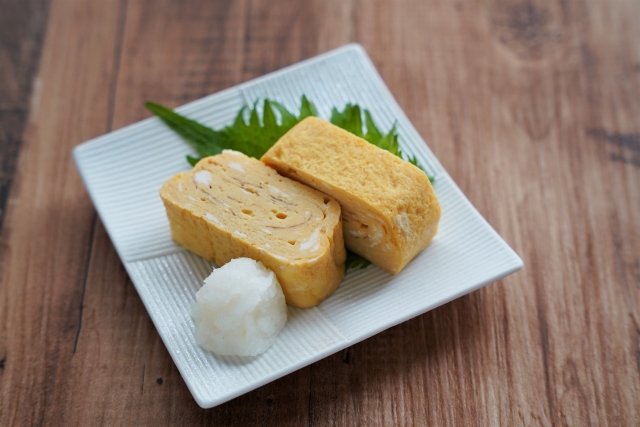
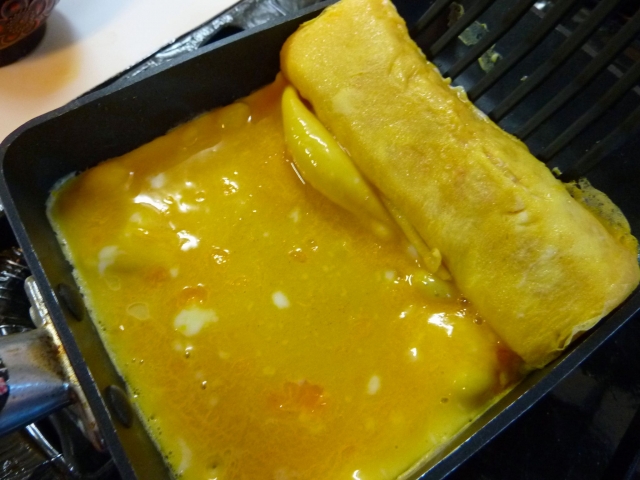
Tamagoyaki is a Japanese rolled omelet that is often seasoned with salt and soy sauce. It is slightly different from what is thought of as an omelet in other countries; the most notable feature is a unique shape which consists of layers of eggs. This omelet is super popular in Japan and you will often see it on the menu at sushi restaurants or sometimes even freshly prepared at markets. In our Tsukiji food & drink tour you will also see how the omelet is made and try some fresh tamagoyaki yourself! The original recipe doesn’t require any ingredients in it except seasoning and enjoy the simple taste. You can also make a sweet one with sugar, which is always popular as a side dish in lunch boxes for children in Japan.
Tamagoyaki Recipe
Ingredients:
- Eggs
- Dashi
- Salt
Instructions:
- Beat eggs with a little sugar, soy sauce, and dashi.
- Pour a thin layer of egg into a rectangular tamagoyaki pan and cook over low heat.
- Roll the egg, push it to one side, and add more egg mixture to the pan.
- Repeat until all the egg is used, then slice into pieces.
▶It might be difficult to create a nicely shaped tamagoyaki at first, so why not Take a cooking class?
8. Shogayaki (生姜焼き)
Shogayaki is a popular Japanese dish which can be described as grilled/pan-fried (yaki) pork with ginger (shoga). It is one of the most common pork dishes to be made at home and also Japanese salarymen’s one of the most popular dishes, right after tonkatsu. Shogayaki consists of sliced pork and grated ginger, grilled with sliced onions. The typical seasoning is soy sauce, cooking sake and mirin (another type of sweet cooking sake). Compared to other meat dishes such as karaage and tonkatsu, it is relatively easy to make in a short time, even for beginners!
Shogayaki Recipe
Ingredients:
- Pork
- Grated ginger
- Soy sauce
- Sugar
- Sake
- Mirin
- Sesame oil
Instructions:
- Slice pork thinly and marinate with grated ginger, soy sauce, and mirin.
- Sauté the pork in a hot pan until cooked through.
- Serve with shredded cabbage and rice.
▶Learn more about one of the most popular home-cooking meals!
9. Okonomiyaki (お好み焼き)
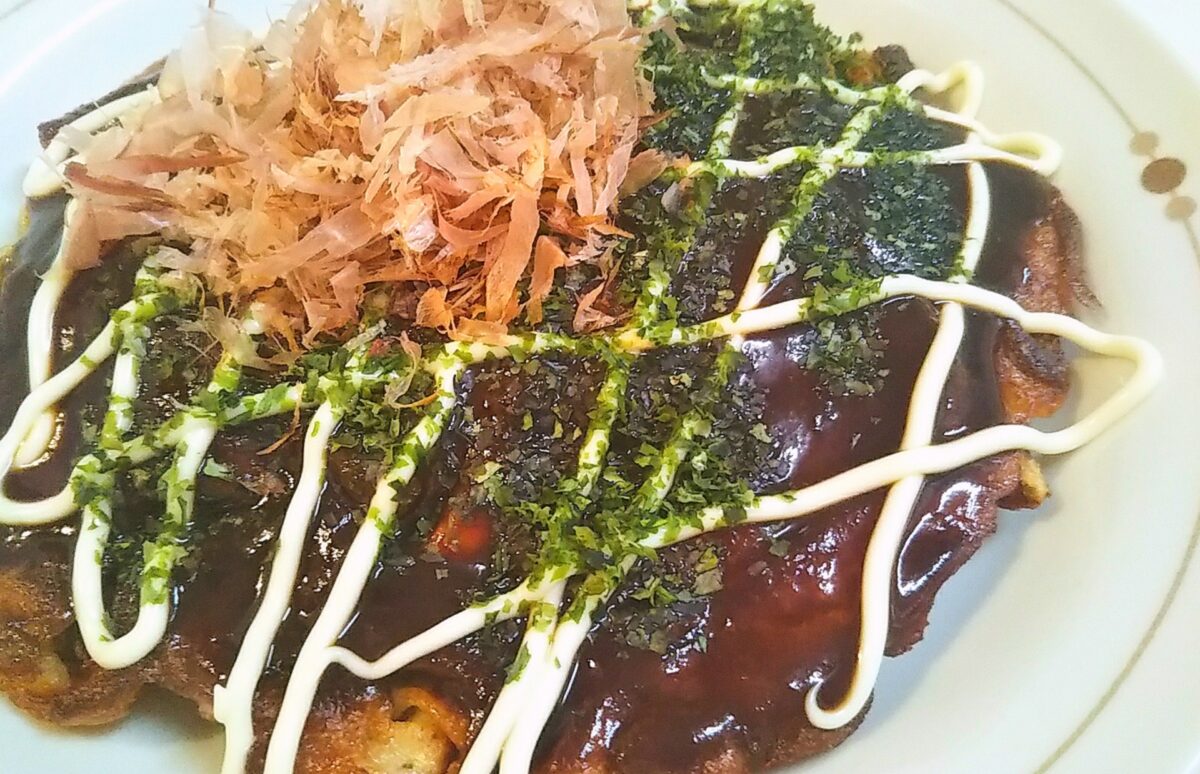
Okonomiyaki is a specialty made famous by the food capital of Japan: Osaka! This delicious dish is available everywhere and, because of it’s nature (okonomiyaki = “grill what you like”), it has tons of different varieties to enjoy! It makes for a fun group dining experience because you generally order from a list of ingredients and then grill it together as a group. You’ll also be able to maybe try some interesting concoctions that your friends have thought of! In general, it’s a flour and egg based pancake-like dish that is filled with things like meat, cabbage, pickled ginger, and is covered with a special okonomiyaki sauce, mayonnaise, katsuobushi (dried fish shavings), and aonori (a kind of powdered seaweed). Okonomiyaki also has a messier “little brother” called “monjayaki” that is popular in Tokyo, specifically Tsukishima- check it out!
Ingredients:
- Cabbage (shredded)
- All-purpose flour
- Eggs
- Dashi (or water)
- Pork belly slices (or seafood like shrimp or squid)
- Green onions (optional)
- Okonomiyaki sauce
- Mayonnaise
- Bonito flakes (katsuobushi)
- Aonori (dried seaweed powder)
Instructions:
- Mix flour, water, and dashi into a batter. Add shredded cabbage, egg, and your choice of meat or seafood.
- Pour the batter into a hot, oiled pan and shape into a round pancake.
- Flip and cook both sides until golden.
- Serve with okonomiyaki sauce, mayo, bonito flakes, and aonori.
▶ Learn how to make okonomiyaki from a local!
10. Takoyaki (たこ焼き)
Takoyaki is undoubtedly one of the most iconic foods, and just like okonomiyaki, its been made famous by Osaka! The spherical shape certainly makes it a memorable, quirky food that will have most people wanting to try it out. Also similar to okonomiyaki are the ingredients- mainly flour, egg, cabbage, and topped with the same things. The main differences are that there is a chunk of octopus in the center, and it’s fried in a semispherical grill! While this is a very common thing to have at home (especially for get togethers!), you will need a takoyaki grill! Also, the great thing about making it at home is that you can swap out the octopus if you don’t like it (we get it) for something like sausage. also, some people like to play a “russian roulette” kind of game by putting a large amount of wasabi into one of the balls! Not for the faint of heart…
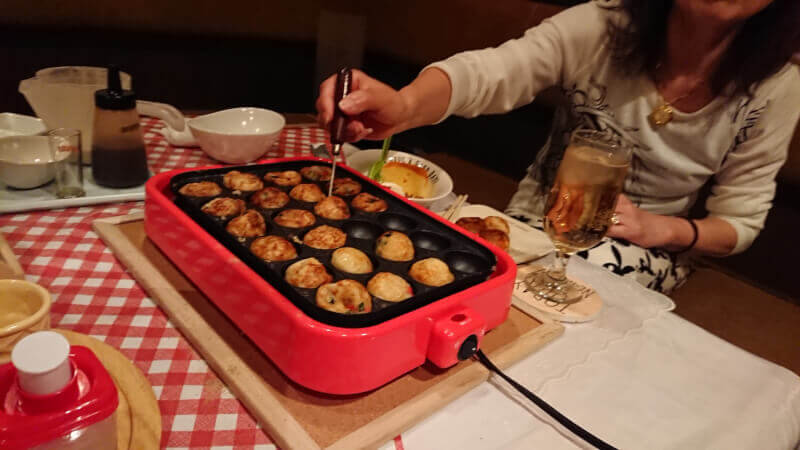
Ingredients:
- Takoyaki flour (or all-purpose flour with dashi powder)
- Eggs
- Dashi stock (or water)
- Octopus (boiled and diced)
- Green onions (finely chopped)
- Pickled ginger (beni shoga)
- Takoyaki sauce
- Mayonnaise
- Bonito flakes (katsuobushi)
- Aonori (dried seaweed powder)
Instructions:
- Mix takoyaki batter using flour, dashi, and egg.
- Heat a takoyaki pan and oil the molds well.
- Pour in the batter, add diced octopus, green onions, and pickled ginger.
- Flip balls with a skewer to cook evenly.
- Serve with takoyaki sauce, mayo, bonito flakes, and aonori.
▶ Learn from a local! Try making takoyaki in Tokyo!
11. Sukiyaki (すき焼き)
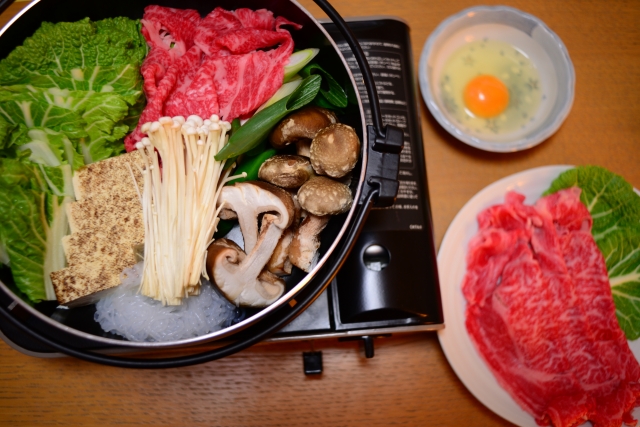
Sukiyaki is a great option for hot-pot lovers! This sweet but savory dish is packed with flavor and protein. It is basically an assortment of vegetables (such as leeks) and tofu, as well as thinly sliced beef. Everything is put into pot (typically made of iron) and simmered and eaten out of the pot which is usually placed in the center of the table on a burner. The sauce/broth that everything is simmered in is a kind of sweet soy sauce type flavor. Typically it is served with a raw egg yolk which is beaten (using your chopsticks) and used for dipping before eating. It’s a simple yet delicious dish that everyone enjoys!
Ingredients:
- Thinly sliced beef
- Tofu (firm or silken)
- Shirataki noodles (konjac noodles)
- Napa cabbage
- Green onions
- Shiitake or enoki mushrooms
- Carrot slices (optional)
- Sukiyaki sauce (soy sauce, sugar, mirin, sake, or store-bought)
- Raw eggs (for dipping, optional)
Instructions:
- Prepare sukiyaki sauce: combine soy sauce, sake, mirin, sugar, and water in a pan; heat until the sugar dissolves. You can also purchase premade versions!
- Heat a shallow pot or pan with oil and cook thinly sliced beef lightly.
- Add tofu, vegetables (e.g., napa cabbage, mushrooms, green onions), and shirataki noodles.
- Pour the sukiyaki sauce over the ingredients and simmer until tender.
- Serve hot, optionally dipping the cooked ingredients into beaten raw egg.
▶ Stay warm and cozy while learning how to make the best Sukiyaki!
12. Karaage (からあげ)
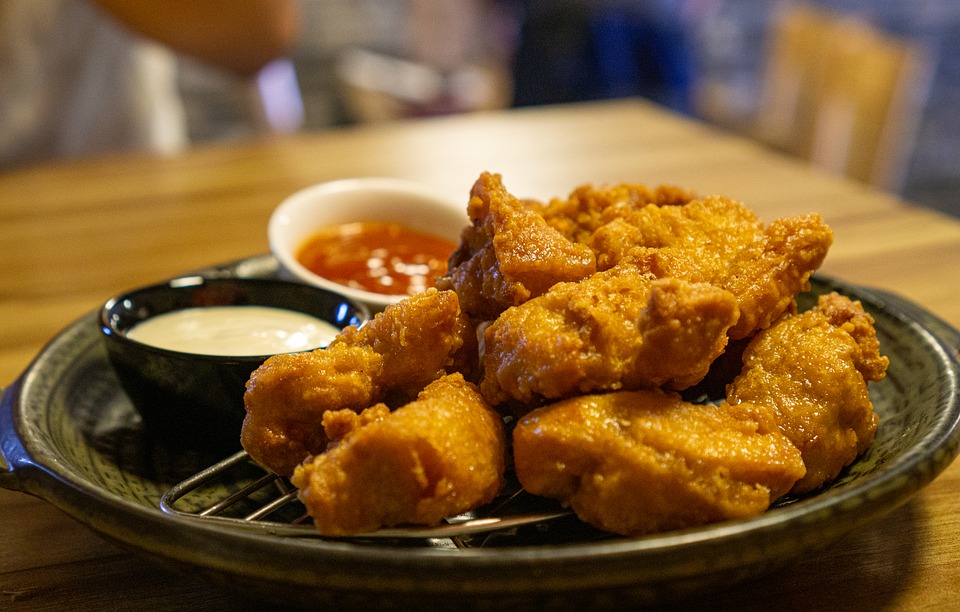
Karaage is a deep fried dish where meat or vegetables are coated in potato starch and deep fried until crisps. Various foods can be used, but fried chicken is definitely the most popular in Japan. Karaage is the standard word for Japanese fried chicken as it’s become known around the world and, nine out of ten times, you will get chicken when ordering karaage at a restaurant. Karaage is also usually made from the chicken’s thigh, whereas many other varieties found in other countries may use breast or another whiter cut. Karaage is also eaten cold in bento boxes – the popular Japanese lunch boxes.
Karaage Recipe
Ingredients:
- Boneless chicken thighs
- Soy sauce
- Sake
- Grated garlic
- Grated ginger
- Potato starch
Instructions:
- Marinate bite-sized pieces of chicken in soy sauce, sake, garlic, and ginger.
- Coat with potato starch or a mix of flour and starch.
- Deep-fry until golden and crispy.
- Serve with lemon wedges.
▶ Cook karaage and onigiri at local’s home
13. Yakizakana (焼き魚)
Yakizakana refers to grilled fish, often one of the essential elements for traditional Japanese-style meals which are typically served in Japanese ryokans. Almost any kind of fish can be used for yakizakana but salmon is the most popular one which adds a bright coral-orange color to the table. The recipe is too simple to mention: just grill the fish until it gets completely cooked! It is best to season the fish with salt and pepper beforehand, and start to grill with the side of skin!
Yakizakana Recipe
Ingredients:
- Filleted of fish of your choice (such as mackerel or salmon)
- Salt
- Grated daikon and soy sauce
- Season fish with salt and let it rest for 15 minutes.
- Grill on a fish grill or under a broiler until cooked through and lightly charred.
- Serve with grated daikon and soy sauce.
▶Learn how to cook Japanese typical meals including grilled fish, miso soup and more!
14. Hambagu (ハンバーグ)
In Japan, you can find two very similar-sounding dishes that are both quite popular: hambagu and hambaga. A “hambaga” refers to the American-style hamburger and is, as you would expect, seen as a foreign dish in Japan. Hambagu refers to a popular Japanese dish similar to hamburg steak or even meatloaf in western countries. It is made from ground meat, chopped onions, eggs and breadcrumbs seasoned with salt and pepper. Mix them carefully in a bowl and form them into patties. Hambagu is usually served with rice or bread, as well as steamed or grilled vegetables or mashed potatoes on the side.
Hambagu Recipe
Ingredients:
- Ground pork/beef
- Onions
- Panko (breadcrumbs)
- Milk
- Salt and pepper
- Nutmeg
- Egg
- Sauce of your choice (teriyaki or demi-glace sauce)
Instructions:
- Mix ground beef and pork with breadcrumbs, milk, egg, and sautéed onions.
- Shape into patties and cook in a hot pan until browned.
- Add sauce made of ketchup and Worcestershire sauce, and simmer briefly.
▶Learn how to make delicious hambagu at home!
15. Oyakodon (親子丼)
The super popular comfort food of Japan, oyakodon is a chicken and egg rice bowl. Oyako (親子) means parent and child, and don (丼) means a bowl (and usually implies something served over rice), so it is literally the “parent-and-child-rice-bowl”. The bowl has bite-sized chicken pieces and soft-cooked eggs as the main ingredients, cooked with sliced onions and soy sauce-based broth soup. Oyakodon is served with white rice in a bowl. The recipe is easy to make for everyone, using basic ingredients. You can also try oyakodon at many restaurants or famous Gyudon (牛丼) chain restaurants.
Oyakodon Recipe
Ingredients:
- Chicken thigh
- Onion
- Eggs
- Water
- Dashi powder
- Sugar
- Soy sauce
- Mirin
- Cooked rice
Instructions:
- Simmer sliced chicken and onions in dashi mixed with soy sauce, sugar, and mirin.
- Pour beaten eggs over the mixture and cook until just set.
- Serve over steamed rice.
▶Book a cooking class to make oyakodon in Hyogo!
16. Udon / Soba (うどん/そば)
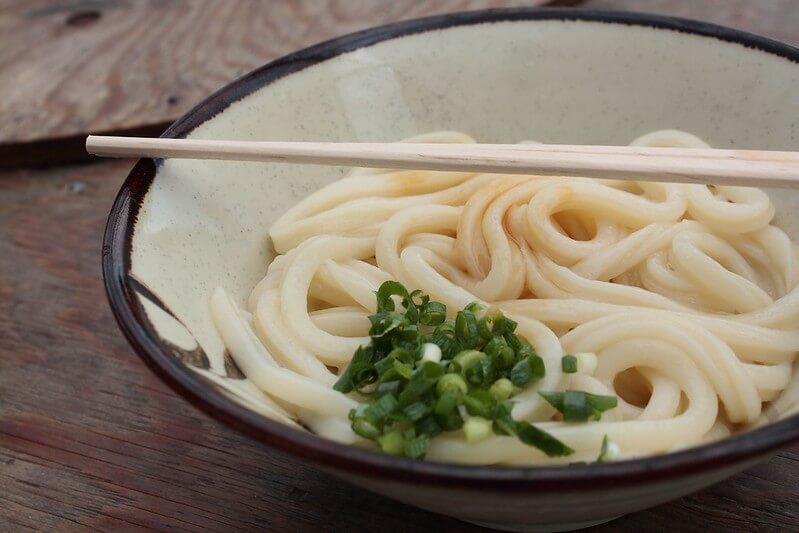

You have probably heard of Udon and Soba noodles, the super popular Japanese noodles which have been loved for over centuries. Japanese noodles are used in numerous dishes in Japan. Udon is a white, flour noodle which is generally thicker than soba (also known as buckwheat noodles). Their history is said to date back at least to the Edo period, and have long been a favorite of Japanese people. They rapidly became popular because of the affordable price and easy recipes. Recently soba noodles have gained attention for its health benefits, the healthy food is a popular diet food and known for energy-storing properties. Both noodles are eaten throughout the year, and on New Year’s Eve Japanese people usually have either of them to celebrate the arrival of the new year and to hope for a long life like the length of the noodles!
Udon/ Soba Recipe
Ingredients:
- Udon or soba noodles
- Toppings of your choice
- Water
- Katsuobushi
- Mirin
- Soy sauce
- Cook udon or soba noodles in boiling water and drain.
- Heat dashi with soy sauce and mirin for the soup base.
- Serve noodles in the soup, topped with green onions, tempura, or nori.
▶Cook udon from scratch at your home (online cooking class)
17. Chirashizushi (ちらし寿司)
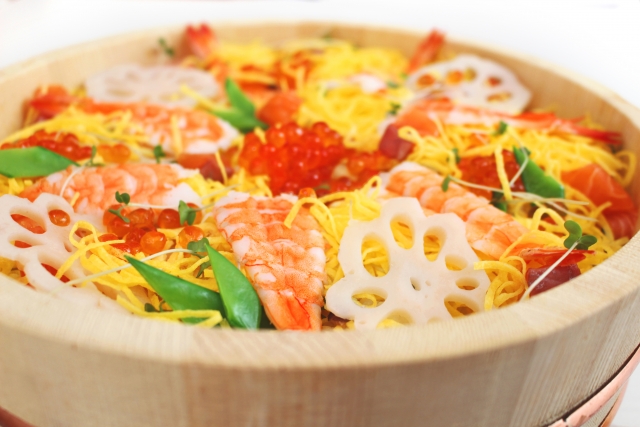
Chirashizushi is a unique type of sushi topped with colorful ingredients. It is generally eaten on March 3rd known as Girl’s Day or Hinamatsuri- one of Japan’s many national holidays – to celebrate healthy growth of girls. Typical toppings include sashimi, boiled shrimp, shiitake mushrooms, eggs, and vegetables. The exact toppings might vary depending on the region or household preferences, but they are usually laid on top on vinegared rice. The beautiful appearance with colorful toppings is perfect as a special dish for the spring season!
Chirashizushi Recipe
Ingredients:
- Cooked rice
- Rice vinegar
- Sugar
- Salt
- Vegetables (carrot, lotus root etc)
- Dried shiitake
- Egg
- Sake
- Soy sauce
Instructions:
- Mix cooked sushi rice with sushi vinegar (rice vinegar, sugar, salt).
- Top with sashimi slices, shredded egg, vegetables, and nori.
▶ Let’s learn how to make chirashizushi at home!
18. Temakizushi (手巻き寿司)
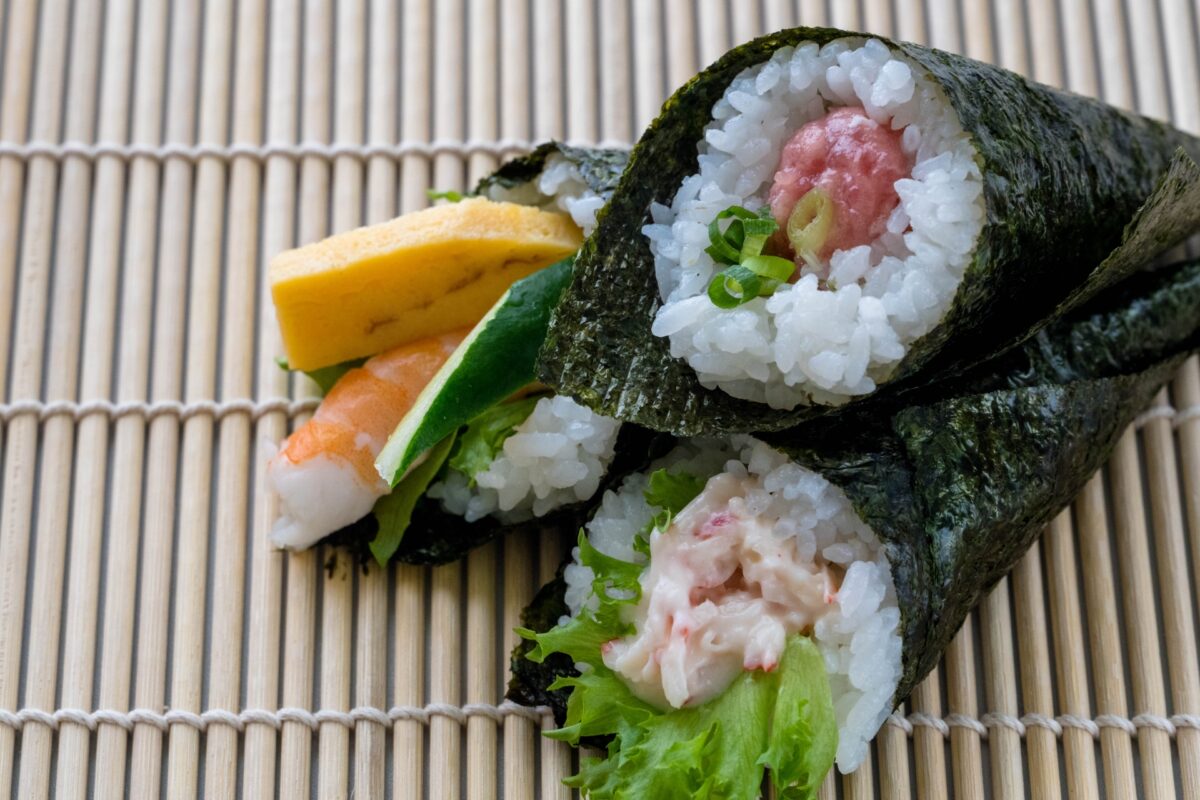
As you can see, sushi is not limited to the nigiri (sashimi on rice) or maki (rolled) forms that you might see at typical sushi restaurants. While the “maki” in temakisushi does mean rolled, the “te” part means hand, so this dish is literally “sushi rolled by hand,” and its a great way to enjoy sushi at home with your friends and family! The rolls you will end up making will look different than the rolls you’ll see at the restaurants; they are more conical and almost taco looking! Choose your favorite sushi ingredients, get some rice and nori, then wrap it up to your hearts content! Don’t forget the soy sauce and wasabi, of course!
Ingredients:
- Nori sheets (seaweed)
- Sushi rice (seasoned with rice vinegar, sugar, and salt)
- Sashimi-grade fish (e.g., tuna, salmon)
- Vegetables (e.g., cucumber, avocado)
- Tamagoyaki (Japanese omelet)
- Soy sauce
- Wasabi
Instructions:
- Prepare sushi rice, nori sheets, and various fillings like sashimi, cucumber, and avocado.
- Place rice and fillings on a nori sheet and roll by hand into a cone shape.
▶ You’ll never need to go to a sushi restaurant again, learn to make it at home!
19. Tonkatsu (とんかつ)
Tonkatsu is a Japanese-style pork cutlet and is loved by the Japanese as one of the most popular meat dishes. It is basically a deep-fried pork cutlet made from thick pork breaded with flour and bread crumbs resulting in a crispy texture. There are a variety of dishes featuring tonkatsu such as Katsu-don (かつ丼), a bowl of rice topped with tonkatsu and egg! Be careful not to order tonkotsu instead, this is a completely different dish – a ramen made of pork bones (it’s incredibly good though, so you probably wouldn’t be disappointed!).
Tonkatsu Recipe
Ingredients:
- Thick sliced pork loin
- Salt and pepper
- Egg
- Flour
- Panko
Instructions:
- Coat pork cutlets with flour, beaten egg, and panko breadcrumbs.
- Deep-fry until golden brown and crispy.
- Serve with shredded cabbage and tonkatsu sauce.
▶ Let’s make tonkatsu with a local in Tokyo!
20. Chawanmushi (茶碗蒸し)
Ever had a savory pudding? It may sound odd, but it can definitely be a tasty addition to your Japanese homecooked meal! While this isn’t a meal on its own (maybe it could be, if you really wanted to), it’s something that you’ll find alongside many traditional dishes as part of the meal. Basically, Chawanmushi is a pudding or custard like dish served in small bowl like dish that typically is made from egg and dashi and includes various pieces of meat and and vegetables such as shiitake mushrooms, lil roots, and protein like boiled shrimp and chicken.
Ingredients:
- Eggs
- Dashi stock
- Soy sauce
- Mirin
- Salt
- Chicken or shrimp (small pieces)
- Shiitake mushrooms
- Kamaboko (fish cake) or narutomaki
- Mitsuba (Japanese parsley) or green onion for garnish
Instructions:
- Beat eggs and mix with dashi, soy sauce, and mirin.
- Pour into small cups with ingredients like shrimp, chicken, and mushrooms.
- Steam gently until the custard is set.
▶ Learn how to make chawanmushi with a local and pair it with some other tasty treats!
Enjoy Japanese cooking experiences
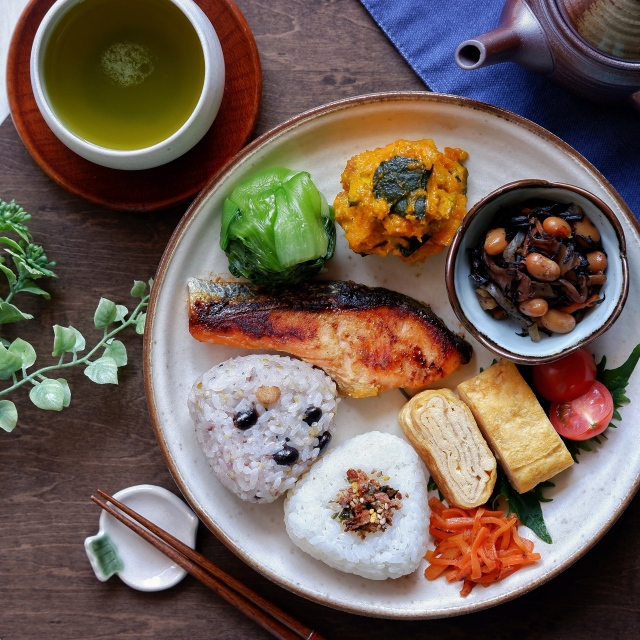
Did you get an appetite for Japanese food but looking for some help preparing these dishes? We have some options to get you started:
An amazing cookbook with basic but authentic Japanese recipes is Just One Cookbook. The recipes in this book are delicious and super easy to follow.
The second option is joining a cooking workshop, like these ones:
- Fun & Delicious! Online Fluffy Omurice class
- Online class: Katsu Curry Japanese curry rice/Japanese food
- Tempura, Handmade Udon, and Dashimakitamago (Japanese Rolled Omelet
Japan Wonder Travel Food Tours
Japan Wonder Travel is a travel agency that offers guided tours throughout Japan.
From private walking tours to delicious Food and Drink tours, we can help organize the best tours just for you! If you want to explore Japan and learn more about the history and backstories of each area you are traveling in, our knowledgeable and friendly guides will happily take you to the best spots!
In addition, we can provide you with any assistance you may need for your upcoming trip to Japan, so please feel free to contact us if you have any questions or need some help!
▶Tokyo Tsukiji Fish Market Food and Drink Tour
Explore the most lively and popular fish market in Tokyo where you will have the chance to try some of the local’s favorite street foods and sake along with your friendly English speaking guide!

▶Shinjuku Bar Hopping Tour: Experience Tokyo’s Nightlife in Izakaya
Check out the best spots in Shinjuku while bar hopping through the lively and vibrant area. Try some delicious local food and drink as you explore the narrow yet photogenic alleys that the town has to offer. Experience Japanese izakaya culture and drink in Shinjuku like the locals!
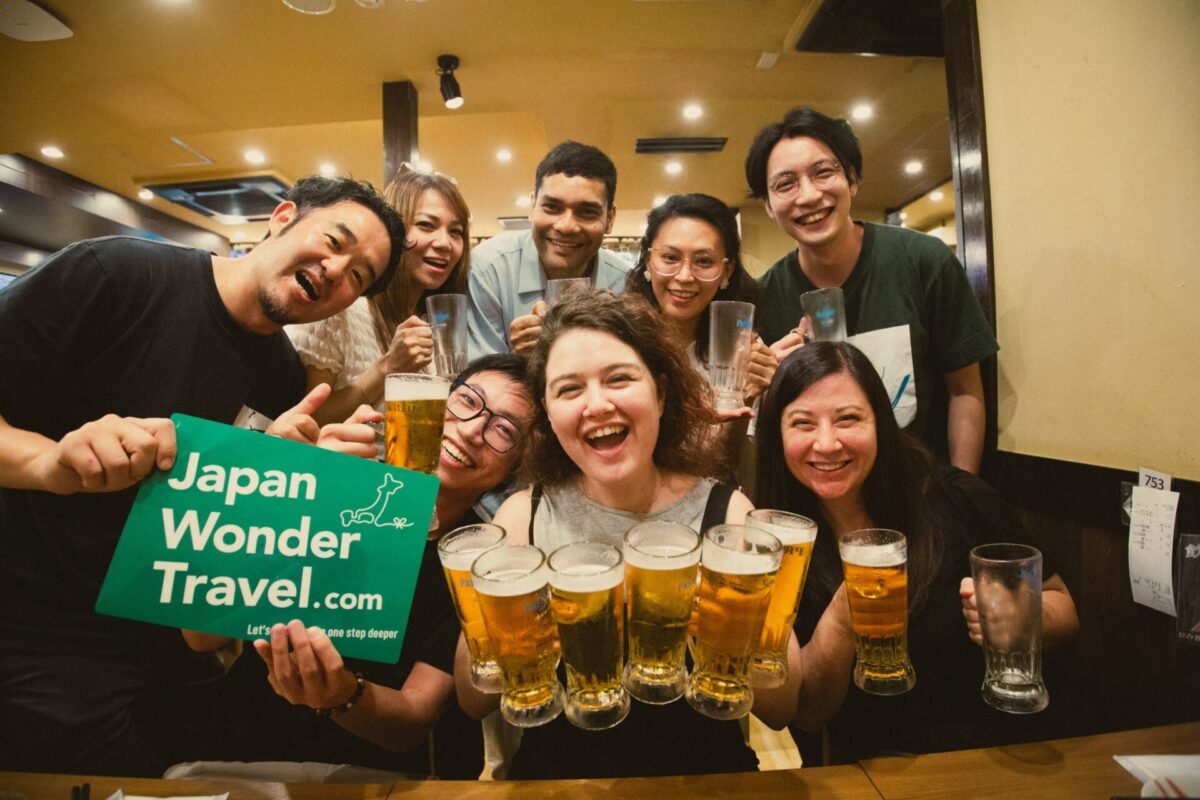
▶Explore Nishiki Market: Food & Culture Walk
If you’re looking to learn more about the culture and the local cuisine of Kyoto, this is the perfect tour for you! Take part in this Kyoto food and drink tour and explore the 400-year-old market and the surrounding areas.
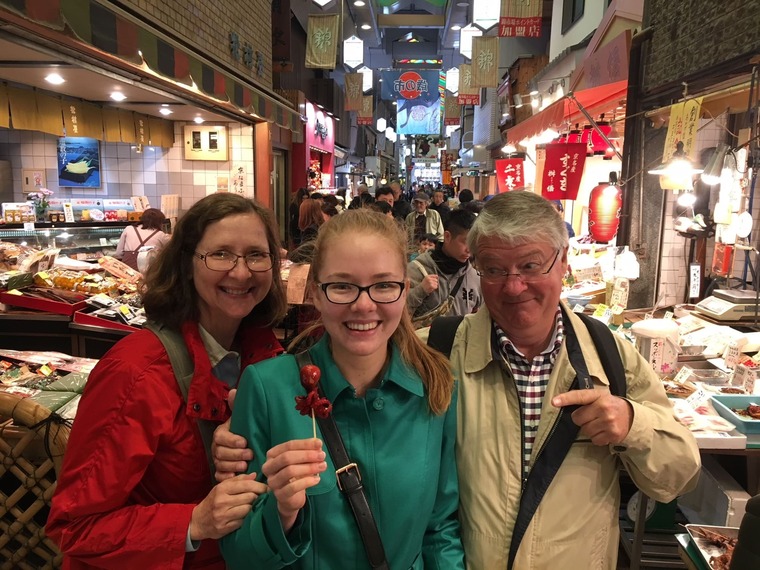
Follow us on Instagram, Facebook and Twitter for more travel inspiration. Or tag us to get featured!
Happy traveling!
Stay informed of the best travel tips to Japan, the most exciting things to do and see, and the top experiences to have with the Japan Wonder Travel Newsletter. Every week we will introduce you to our latest content.
